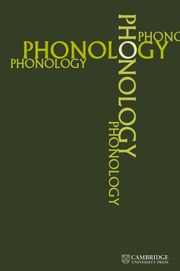Speech errors and the representation of tone in Mandarin Chinese
Published online by Cambridge University Press: 18 November 2002
Abstract
One of the major advances in phonological theory during the past twenty years has been the refinement of a theory regarding the representation and behaviour of tones (Goldsmith 1976, 1990, Fromkin 1978, Clements & Goldsmith 1984, Hyman 1986, 1993, Pulleyblank 1986, 1997), particularly for African tone languages and East Asian tone languages (for recent reviews see Odden 1995 and Yip 1995). A general outline of such a theory, using an autosegmental framework, might be something like the following: (a) Tones or tone melodies are represented in underlying phonological representations (UR); in some cases they are linked to specific ‘tone-bearing units’ (TBUs) such as syllables, moras or vowels on other tiers in UR, and in other cases they are unlinked. (b) Phonological rules will associate tones with correct TBUs according to universal and language-specific principles, including a universal well-formedness condition, such that no tones or TBUs which remain at the end of the derivation are unassociated. Tones may be delinked and omitted or reassociated by phonological rules, which may involve tone spreading, tone sandhi and a number of other phenomena. (c) Tones have a primarily lexical rather than syntagmatic function. (d) Contour tones are represented in UR as a sequence of two or more level tones, and function as tone sequences in tone rules, such that for example an underlying HL sequence may surface as either a falling contour tone on a single TBU or a high–low sequence on two adjacent TBUs. (e) It is assumed that tonal systems in all languages follow the same universal principles, which underlie the theory outlined here.
Information
- Type
- Research Article
- Information
- Copyright
- © 1998 Cambridge University Press
Footnotes
- 45
- Cited by

